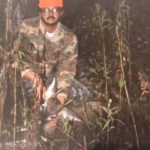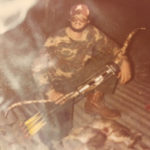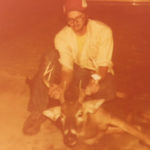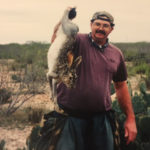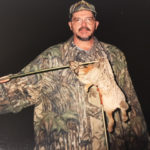Last Updated on November 9, 2018 by Terry
Good Friday afternoon everyone. Gun and deer season is beginning in Arkansas. I have a lot of experience deer hunting. Sometime next year I will finish my hunting adventure book and get it up and running. Many places I go people still ask me to tell them one of my many adventures while hunting. We killed a lot of deer, but sometimes the hunting trip did not finish as planned.
- During hunting trips, I have:
- Fallen from stands several times.
- Been lost overnight two times.
- Shot my arrows at the same deer 6 times in 15 minutes. (All misses)
- Killed two deer with one shot, on purpose!
I have also had a lot of misunderstandings with game wardens and local authorities.
I have been:
- Detained for Spotlighting deer (I really wasn’t)
- Arrested for Spotlighting Beaver (I really was)
- In a car chase for stealing a Deer Head? (ok, bad idea)
- Detained for casing a bank and jewelry store. (That’s a lie, I was stalking some women in front of the bank and jewelry store.)
- Pulled over for suspected bank robbery (I mean, do I look like a bank robber?) (And no, I did not do it.)
So, I KNOW deer hunting!
Anyway, I thought we could all use some safety tips. Please read the following hunting safety information. It’s my gift to you. (I need to get to work on that hunting book)
Hunting Safety
The Leading Fatality Causing Accidents While Hunting
1-TREESTAND ACCIDENTS
The trees, that is anything to do with climbing while hunting, are where most of our accidents happen. All across the south, (1) tree stand accidents are confirmed as the number 1 cause of hunting related injuries. ***
Each year, countless people fall from trees and stands resulting in serious injuries. Many of these falls happen during setting up the stand. If a fall victim leaves with a few bumps and bruises, they are lucky. Many falls result in broken bones, paralysis, and even severe brain damage. Many of these accidents result in death due to their fall.
Most of these deaths are the result of obvious causes such as brain damage, and broken spine or neck. Other more obscure deaths are from being impaled on a steel fencepost or tree branch, or even hung upside down in a poor quality safety harness. The possibilities for a fatal tree stand fall are endless.
Homemade stands
Metal: even if you are pretty good at welding, let someone help you inspect it before using. If it’s older, look for corrosion before climbing.
Wooden: Fact, wood rots. Even a stand you built last year may have some damage. Be very careful and inspect it before climbing.
Tips for Prevention:
- Inspect your stand and every component of your safety harness.
- Use proper safety equipment when hunting from elevated stands.
- Use a proper safety harness while in your stand and some degree of safety while installing the stand.
- Install the stand per manufacturer instructions.
- Practice installing the stand at ground level before climbing to install.
- Never carry anything such as a weapon, extra clothes, or other gear while climbing.
- Make sure gun is unloaded or broad heads covered before pulling them up.
- Make sure someone knows where your stand is located and when you should return from your hunt.
2-ACCIDENTAL SHOOTINGS
Each year many people are killed by other hunter’s bullets. Often times, people are mistaken for deer, and shot by a partner or relative. Poor communication between hunters regarding their locations results in a large portion of the accidental shootings each season. Ricocheting bullets cause injuries as well. Improper loading, unloading, and handling of firearms cause most self-inflicted gunshot wounds. It’s important to remember, a gun’s safety is a mechanical device, and can fail. About 10% of all accidental shootings are deadly. (2) Be sure of the target, and what is behind it,*** and wear hunter orange!
10 Absolutes of Firearm Safety:
- Treat every gun as if it were loaded.
- Always be aware of where the gun’s muzzle is pointed.
- Unload guns when not in use.
- Be sure the barrel is clear of obstructions.
- Be sure of your target before you pull the trigger.
- Never point a gun at anything you do not want to shoot.
- Never climb a tree or fence or jump a ditch with a loaded firearm.
- Never shoot a bullet at a flat, hard surface or water.
- Store guns and ammunition separately.
- Avoid alcoholic beverages before and during shooting.
3- ATV ACCIDENTS
The ATV has become a staple in many deer camps throughout the country and for good reason. ATV’s are fun to drive and can be quite a useful tool for anything from clearing food plots, cutting trails and trees to dragging out your game. Each year many people are fatally injured in ATV accidents and many are hunters. A thick layer of insulated camouflage clothing doesn’t protect against a crash. A scent eliminating mask doesn’t double as a safe and secure helmet. Drive smart & be safe.
Common causes of ATV crashes are:
- Driver error (Speeding)
- Carrying a passenger
- Poor judgment of distance
- Loss of control
- Vision problem
® An ATV is not a toy. Children should not be permitted to operate ATVs without specialized training and then they should be allowed to only operate an ATV of an appropriate size. Contact the ATV Safety Institute to enroll in a course.
® Be sure the ATV is appropriate for the age of the operator.
® ATVs with an engine size greater than 90cc should only be operated by people at least 16 years of age.
® Wear appropriate riding gear: DOT approved helmet and proper goggles, gloves, over-the-ankle, long-sleeve shirt and long pants.
® Read owner’s manuals carefully.
® Most ATVs are not made for multiple riders. Never carry anyone else on the ATV unless approved by manufacturer.
® Any added attachments affect the stability, operating and braking of the ATV.
® Just because an attachment is available doesn’t mean that it can be used without increasing your risk of being injured.
® Do not operate the ATV on streets, highways or paved roads.
*No “trick” riding or stunts.
*Take a hands-on ATV Rider Course and the free online E-Course.
Inspection
Are tires and wheels in good condition?
Are controls and cable operational?
Does the chain have proper slack and is it lubricated?
Is riding gear (including a helmet) available and worn?
Plan for the Hunt and Hunt with a Plan!
Make sure someone knows where you will be hunting!
